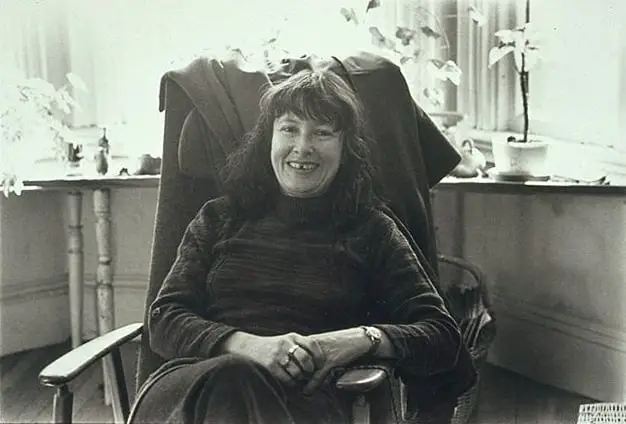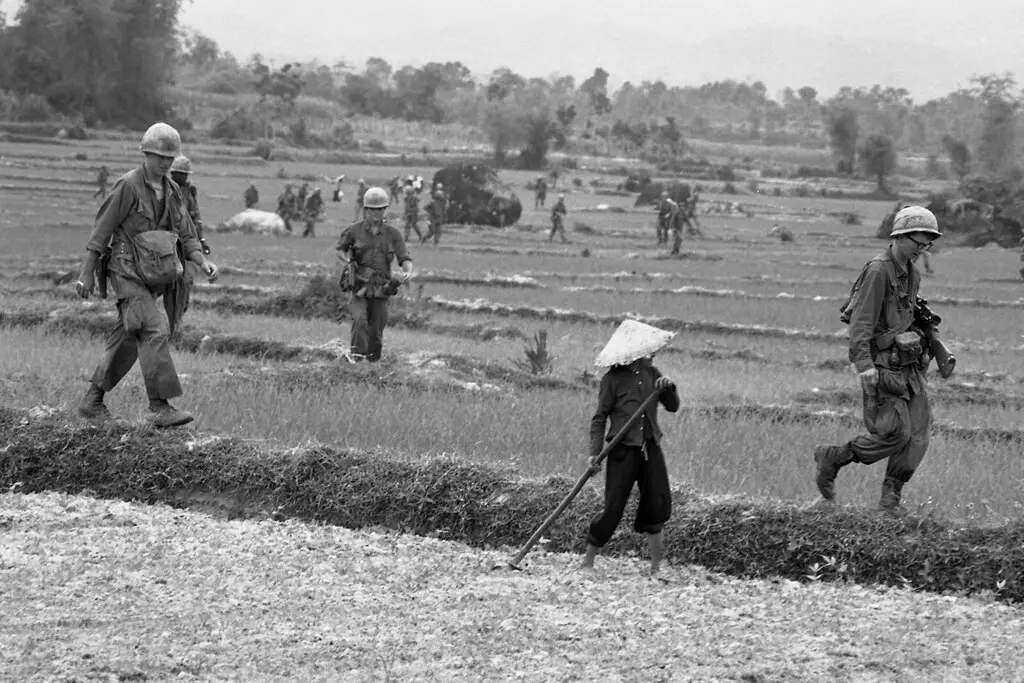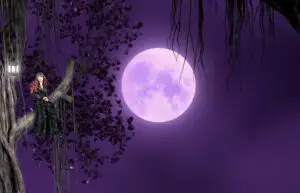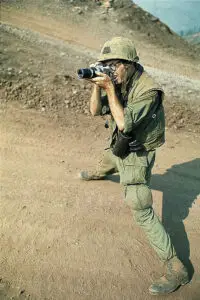
FULL POEM - SCROLL DOWN FOR LINE-BY-LINE ANALYSIS
Did the people of Viet Nam
use lanterns of stone?
Did they hold ceremonies
to reverence the opening of buds?
Were they inclined to quiet laughter?
Did they use bone and ivory,
jade and silver, for ornament?
Had they an epic poem?
Did they distinguish between speech and singing?
Sir, their light hearts turned to stone.
It is not remembered whether in gardens
stone gardens illumined pleasant ways.
Perhaps they gathered once to delight in blossom,
but after their children were killed
there were no more buds.
Sir, laughter is bitter to the burned mouth.
A dream ago, perhaps. Ornament is for joy.
All the bones were charred.
it is not remembered. Remember,
most were peasants; their life
was in rice and bamboo.
When peaceful clouds were reflected in the paddies
and the water buffalo stepped surely along terraces,
maybe fathers told their sons old tales.
When bombs smashed those mirrors
there was time only to scream.
There is an echo yet
of their speech which was like a song.
It was reported their singing resembled
the flight of moths in moonlight.
Who can say? It is silent now.

SUMMARY AND CONTEXT
‘What Were They Like’ is a poem modeled from a unique question and answer type narrative between two speakers, envisaging a Vietnam completely destroyed following American victory in the Vietnam War (1955-75), resulting in the loss of all Vietnamese culture and lifestyle. In the first stanza, one speaker asks of the lives of the Vietnamese people preceding the war, with the second speaker responding hazily about their mysterious lives with almost all knowledge dying with the people, and about the grave realities of the present day and the tragedy of the war. Political matters, in particular the Vietnam War, were major themes of Levertov’s poetry during the 1960s and 1970s when she became very politically active, also joining the War Resisters League and signing the “Writers and Editors War Tax Protest”. She believed it to be a ‘poet’s calling’ to protest against and raise awareness about the tragedy and brutality of the Vietnam War.
LINE-BY-LINE ANALYSIS
STANZA 1
Did the people of Viet Nam
use lanterns of stone?
The first stanza poses questions about Vietnamese culture and civilization preceding the country’s hypothetical annihilation during the war, from the perspective of the first speaker – perhaps a student or journalist. The tone of this first question is very literal and matter of fact. In the second stanza, the responder replies that It is ‘not remembered’, which highlights the extent to which knowledge of the Vietnamese lifestyle has been lost, hence, the sheer loss of people, buildings and the landscape that took place.
Did they hold ceremonies
to reverence the opening of buds?
The imagery of the ‘opening of buds’ in the second question connotes the growth of new life and hope which spring, the season in which this occurs, is a metaphor for. This image of new life and hope juxtaposes the loss of lives during the war that the responder explains in the second stanza. This contrast makes this revelation even more emotive to the reader.
Were they inclined to quiet laughter?
The thought of the people laughing humanises them – enabling the reader to visualise and empathise with them as people and not just artifacts of the past. This increases the poignancy of the revelation of their deaths in the second stanza.
Did they use bone and ivory,
jade and silver, for ornament?
‘Bone and ivory’ are white materials, symbolising innocence and purity. ‘Jade and silver’ are more delicate and beautiful. This infers that the Vietnamese people lived innocent, harmless lives, stressing the unjustness of their slaughter.
Had they an epic poem?
Did they distinguish between speech and singing?
An epic poem is a long narrative poem written in verse about a hero and their heroic, sometimes supernatural, deeds. It often involves dealing with the Gods and is culturally significant, providing a basis for cultural foundation.
STANZA 2
In the second stanza, the second speaker (perhaps a historian) responds to the questions raised by the first speaker, revealing the grave realities of the war and the sheer extent of Vietnamese fatalities.
Sir, their light hearts turned to stone.
It is not remembered whether in gardens
stone gardens illumined pleasant ways.
This is the second speaker’s response to the first question. ‘Their light hearts turned to stone’ takes the image of the ‘stone lanterns’ in the question and transforms it into a poignant metaphor for death (the hearts of the people turn cold, hard and no longer beat when they die, resembling stone). The responder also imparts the extent to which the knowledge of Vietnamese culture and lifestyle has been lost as the answer to this simple question is ‘not remembered’ and cannot be answered.
Perhaps they gathered once to delight in blossom,
but after their children were killed
there were no more buds.
The response to the second question is particularly brutal for two main reasons. Firstly, the disparity between the speculation of them, once upon a time, gathering ‘to delight in blossom’ and their eventual, tragic fate. And, secondly, the emotive image of the buds no longer flowering in the aftermath of the children’s deaths. This image symbolises the loss of life and hope endured by the Vietnamese people during the war.
Sir, laughter is bitter to the burned mouth.
Bombing and chemical warfare (including the tactical use of Rainbow Herbicides by US forces during the war, a form of herbicidal warfare) burned the mouths of the Vietnamese people. The use of the word ‘bitter’ implies sharp pain and resentment to unjust treatment. This is especially poignant as it captures the pain the Vietnamese people experienced as well as the fact they were innocents, unjustly victims of war.
A dream ago, perhaps. Ornament is for joy.
All the bones were charred.
it is not remembered. Remember,
most were peasants; their life
was in rice and bamboo.
The ornaments that the first speaker described in the first stanza objectify ‘joy’, beauty and luxury. These are so distant and removed from the ultimate, tragic reality of their lives that they are but a dream away. This sense of joy was burned away, just like the people’s bodies – war has destroyed them in both a physical and psychological sense. The sole remains (akin to ash in a fire) is death and despair.
When peaceful clouds were reflected in the paddies
and the water buffalo stepped surely along terraces,
maybe fathers told their sons old tales.
The second speaker offers a glimpse into the once-peaceful lives of the Vietnamese peasants, portraying a calm and tranquil image of the natural world. This imagery depicts a sense of harmony between the ‘clouds’, ‘paddies’, ‘water buffalo’ and the people – representing unity in the natural world.
When bombs smashed those mirrors
there was time only to scream.
The disturbance of peace and the natural world caused by the man-made phenomenon of war and ‘bombs’ , juxtaposes the tranquility and unity of nature portrayed in the previous three lines. ‘There was time only to scream’ conveys a feeling of panic and turmoil, emphasising the extent to which war forced the nation from serenity into chaos.
There is an echo yet
of their speech which was like a song.
‘an echo’, like the phrase ‘a dream ago’, highlights just how distant these times of song (associated with joy) are.
It was reported their singing resembled
the flight of moths in moonlight.
The description of their singing as resembling the image of ‘the flight of moths in moonlight’ is a notable one. Moths are a polyphyletic group of insects that are fast-moving, delicate and are attracted to light – the moonlight in this case. The white colour of the moonlight symbolisises purity and innocence. Therefore, the image represents the innocence and vulnerability (the delicacy of the moths signifies the fragility of life) of the Vietnamese peasants.
Who can say? It is silent now.


